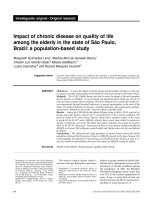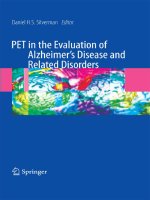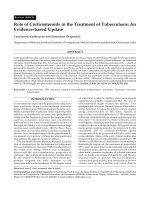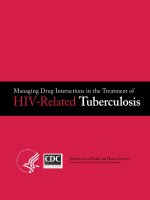In the name of GOD Cough
Bạn đang xem bản rút gọn của tài liệu. Xem và tải ngay bản đầy đủ của tài liệu tại đây (464.64 KB, 28 trang )
In the name of GOD
Cough
Brought to you by
:Definition
Cough is an protective mechanism that
ensures the removal of mucus, noxious
substances, and infectious organisms
from the larynx, trachea, and large
bronchi .
Cough is an explosive expiration that
provides a normal protective mechanism
for clearing the tracheobronchial tree of
secretions and foreign material.
cough interference with normal lifestyle,
and concern for the cause of the cough,
especially fear of cancer.
Brought to you by
Mechanism
Coughing may be initiated either voluntarily
or reflexively.
As a defensive reflex it has both afferent and
efferent pathways .
The cough starts with a deep inspiration
followed by glottic closure, relaxation of the
diaphragm, and muscle contraction against a
closed glottis.
Brought to you by
Etiology
An exogenous source
(smoke, dust, fumes, foreign bodies)
An endogenous origin
(upper airway secretions, gastric contents).
Any disorder resulting in inflammation, constriction, infiltration, or
compression of airways can be associated with cough.
Asthma is a common cause of cough.
In a nonsmoker the most common causes of chronic cough are postnasal drip ,
asthma, and gastroesophageal reflux
Brought to you by
Etiology
Acute cough (<3 weeks)
Is most often due to upper respiratory infection (common cold,
acute bacterial sinusitis, and pertussis), serious disorders,
such as pneumonia, pulmonary embolus, and congestive
heart failure, can also present in this fashion.
Sub acute cough (between 3 and 8 weeks)
Is commonly post-infectious, resulting from persistent airway
inflammation and/or postnasal drip following viral infection,
pertussis, or infection with Mycoplasma or Chlamydia.
Chronic cough (>8 weeks)
In a smoker raises the possibilities of asthma, COPD or
bronchogenic carcinoma, Eosinophilic Bronchitis ,
Esophageal Disease, Post Nasal Drip , ACEI , Smoking.
Brought to you by
Common Causes of Chronic
Cough
Postnasal drip (38-87%)
Asthma (14-43%)
GERD (10-40%)
Chronic Bronchitis (0-12%)
More than one cause (24-72%)
Brought to you by
(Chronic cough (> 8 weeks
Chronic Cough of Post-Nasal Drip
PNDS is a symptom complex without objective findings.
The diagnosis is by a history of the sensation of “something dripping into the
throat,” frequent throat clearing, nasal congestion or discharge.
There is wide cultural diversity in reporting such symptoms by patients with
“colds.”
In the USA, 50% with colds reported these symptoms, in the UK less than 25%,
and in Latin America and India almost none.
Cough may be the only manifestation of PNDS. There may be no symptoms of the
“drip.”
PNDS is often seen due to Allergic Rhinitis, Non-Allergic Rhinitis, Vasomotor
Rhinitis and Chronic Bacterial Sinusitis.
Brought to you by
(Chronic cough (> 8 weeks
Asthma
Asthma is a chronic inflammatory disease of airways
characterized by increased responsiveness of the tracheobronchial tree to many stimuli.
Physiologically there is a reversible narrowing of bronchi and
clinically there are paroxysms of wheezing, cough, and
dyspnea.
If airway obstruction exists, reversibility is shown by > 12% ↑
in FEV1 after two puffs of a β2-adrenergic agonist.
Brought to you by
(Chronic cough (> 8 weeks
Gastro-esophageal disease (GED)
There are two main mechanisms of cough in GED:*
1- Micro or macro-aspiration of esophageal contents into the
tracheo-bronchial tree.
2- Acid in the distal esophagus stimulating a vagally
mediated esophageal-tracheobronchial cough reflex (GI
symptoms may be absent).
Brought to you by
Less Common Causes of
Chronic Cough
Bronchiectasis (0-5%)
ACE inhibitor Rx
Post-infectious
Occult aspiration
Lung Cancer
Occult CHF
Interstitial Pulmonary
Fibrosis
Occult infection
(eg atypical mycobacteria)
Foreign body
Industrial bronchitis
Nasal polyps
Problems with:
- Auditory canal
- Larynx
- Diaphragm
- Pleura
- Pericardium
- Esophagus
Psychogenic
Brought to you by
Approach to the Patient: Cough
A detailed history
Physical examination
Chest radiography
Pulmonary function testing
Gross and microscopic examination of sputum
High-resolution computed tomography (HRCT)
Fiberoptic bronchoscopy
Brought to you by
Algorithm
For
evaluation of
sub acute
and
Chronic cough
Brought to you by
Brought to you by
Cough: Treatment
Definitive treatment of cough depends on determining the
underlying cause and then initiating specific therapy.
Elimination of an exogenous inciting agent (cigarette
smoke, ACE inhibitors) or an endogenous trigger
(postnasal drip, gastro esophageal reflux).
Empirical approach to treatment is with an antihistaminedecongestant combination, nasal glucocorticoids, or nasal
ipratropium spray to treat unrecognized postnasal drip
Brought to you by
Nonspecific therapy; Cough
1- The cause of the cough is not known or specific treatment is not
possible, and
2- The cough performs no useful function or causes marked
discomfort or sleep disturbance.
An irritative, nonproductive cough may be suppressed by an
antitussive agent, which increases the latency or threshold of the
cough center.
Such agents include codeine (15 mg qid) or nonnarcotics such as
dextromethorphan (15 mg qid).
Brought to you by
Hemoptysis
Brought to you by
:Definition
Hemoptysis:
Expectoration of blood from the respiratory tract
Massive hemoptysis:
Expectoration of >100–600 mL over a 24-h period
Brought to you by
?Etiology: Hemoptysis? Hematemesis
It is important to determine initially that the blood is not coming
from alternative sites.
Dark red appearance versus bright red appearance.
An acidic pH, in contrast to the alkaline pH of true hemoptysis.
Brought to you by
Brought to you by
(Differential Diagnosis(1
Tracheobronchial source
Neoplasm (bronchogenic carcinoma, endobronchial
metastatic tumor, Kaposi's sarcoma, bronchial
carcinoid)
Bronchitis (acute or chronic)
Bronchiectasis
Broncholithiasis
Airway trauma
Foreign body
Brought to you by
(Differential Diagnosis(2
Pulmonary parenchymal source
Lung abscess
Pneumonia
Tuberculosis
Mycetoma ("fungus ball")
Goodpasture's syndrome
Idiopathic pulmonary hemosiderosis
Wegener's granulomatosis
Lupus pneumonitis
Lung contusion
Brought to you by
(Differential Diagnosis(3
Primary vascular source
Arteriovenous malformation
Pulmonary embolism
Elevated pulmonary venous pressure
(esp. mitral stenosis)
Pulmonary artery rupture
Miscellaneous/rare causes
o Pulmonary endometriosis
(catamenial hemoptysis)
o Systemic coagulopathy or
o Use of anticoagulants or thrombolytic agents
Brought to you by
Approach to the Patient
History ( acute, chronic, drugs…)
Previous or coexisting disorders
Physical examination
Chest radiograph
Lab. (complete blood count, a coagulation profile, Gram and
acid-fast stains
Fiberoptic bronchoscopy or Rigid FB.
HRCT (suspected bronchiectasis )
Brought to you by
Hemoptysis: Treatment
The rapidity of bleeding
Gas exchange
Massive or blood-streaking
Partially suppressing cough
Isolation of the right and left mainstem bronchi by double-lumen
endotracheal tubes
inserting a balloon catheter through a bronchoscope
Laser phototherapy, electrocautery
Bronchial artery embolization
Surgical resection of the involved area of lung
( for the life-threatening hemoptysis )
Brought to you by
This platform has been started by
Parveen Kumar Chadha with the
vision that nobody should suffer the
way he has suffered because of lack
and improper healthcare facilities in
India. We need lots of funds
manpower etc. to make this vision a
reality please contact us. Join us as
.a member for a noble cause
Brought to you by









